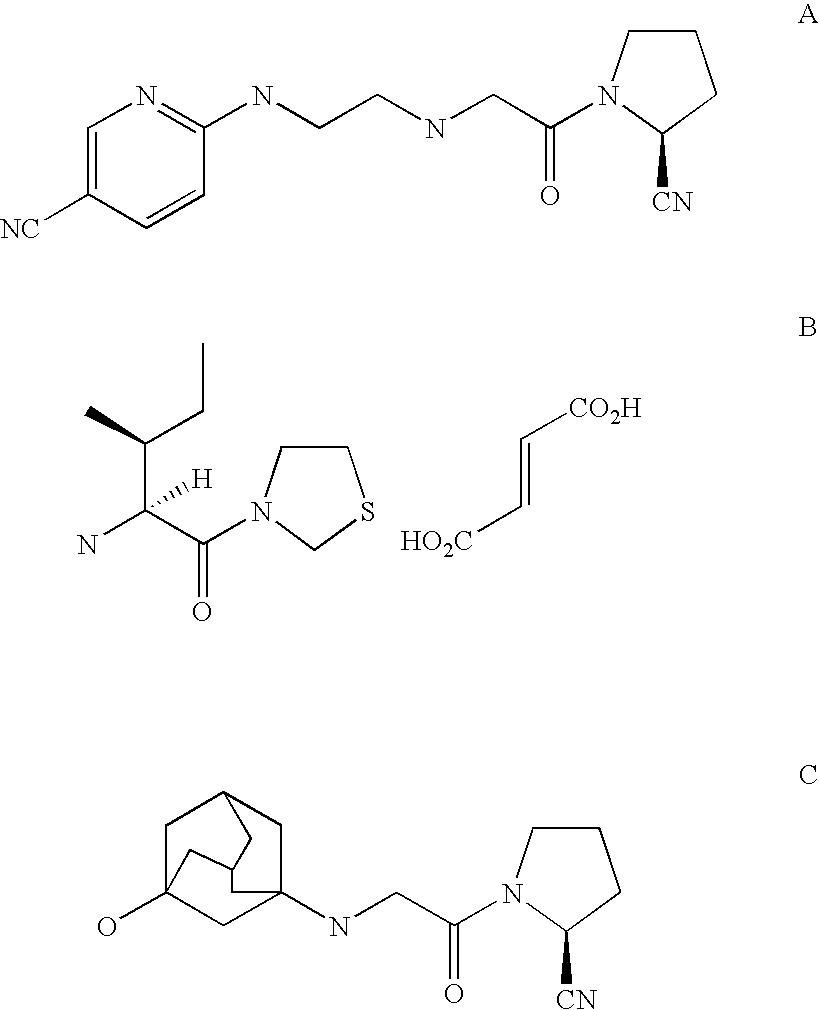Dipeptidyl peptidase IV inhibitors pharmaceutical compositions containing them, and process for their preparation
a technology of peptidase and inhibitor, which is applied in the field of dppiv inhibitors, can solve the problems of increased and premature morbidity and mortality, increased risk of macrovasuclar and microvascular complications in patients with type 2 diabetes mellitus, and increased risk of macrovasuclar and microvascular complications in patients
- Summary
- Abstract
- Description
- Claims
- Application Information
AI Technical Summary
Problems solved by technology
Method used
Image
Examples
example 1
(1SR,3RS)-3-{2-[(2S)-2-Cyanopyrrolidin-1-yl]-2-oxoethylamino}cyclopentane-1-carboxamide
[0307]
Step 1: (1SR,3RS)-3-N-BOC-Aminocyclopentane-1-carboxamide: Ethyl chloroformate (1.06 g, 9.825 mmol) was added to a stirred solution of Intermediate 2 (1.5 g, 6.550 mmol) and triethylamine (0.99 g, 9.825 mmol) in dry THF (15 ml) at 0° C. over 5 min under nitrogen atmosphere. The reaction mixture was stirred for another 30 min at the same temperature and 25% aqueous ammonium hydroxide (15 ml) was added over 5 min. The mixture was then stirred at RT for 18 h. The mixture was diluted with water (50 ml), and extracted with ethyl acetate (3×30 ml). The combined organic extracts were washed with 1N NaOH (50 ml), water (100 ml) and brine (50 ml). The organic extract was dried (Na2SO4) and concentrated under vacuum to give 1.49 g of the product as a white solid; IR (KBr) 3376, 3316, 1661, 1533, 1308 cm−1; 1H NMR (CDCl3, 300 MHz) δ 1.43 (s, 9H), 1.68–1.98 (m, 5H), 2.08–2.18 (m, 1H), 2.69–2.74 (m, 1H) ...
example 2
(2S)-1-{2-[(3SR,1RS)-3-Cyanocyclopentylamino]acetyl}-2-pyrrolidinecarbonitrile
[0308]
Step 1: (1SR,3RS)-3-N-BOC-Aminocyclopentane-1-carbonitrile: Trifluoroacetic anhydride (1.18 g, 5.613 mmol) was added to a solution of Step 1 intermediate of Example 1 (800 mg, 3.507 mmol) and triethylamine (1.7 g, 16.84 mmol) in dry THF (20 ml) at 10° C. under nitrogen atmosphere. The mixture was stirred for 1 h and diluted with ice-cold water (40 ml). The product was extracted into dichloromethane (100 ml), washed with water (100 ml), brine (50 ml) and dried (Na2SO4). Evaporation of the solvent under reduced pressure gave 920 mg of the product as a semisolid; IR (neat) 3361, 2982, 2239, 1680, 1628, 1165 cm−1; 1H NMR (CDCl3, 300 MHz) δ 1.44 (s, 9H), 1.59–1.81 (m, 3H), 2.00–2.10 (m, 2H), 2.39–2.49 (m, 1H), 2.79–2.85 (m, 1H), 4.03 (brs, 1H), 4.60 (brs, 1H).
Step 2: (1SR,3RS)-3-Aminocyclopentane-1-carbonitrile trifluoroacetate: Deprotection of Step 1 intermediate (620 mg, 2.95 mmol) as described in Examp...
example 3
(2S)-1-{2-[(3SR,1RS)-3-Cyanomethylcyclopentylamino]acetyl}-2-pyrrolidine carbonitrile
[0309]
Step 1: (1SR,3RS)-3-N-BOC-Aminocyclopentylmethyl cyanide: To a solution of Intermediate 4 (1.5 g, 6.55 mmol) in DMF (15 ml) was added NaCN (321 mg, 6.55 mmol) and the mixture was heated at 80° C. for 18 h. The mixture was cooled and diluted with water (100 ml). The mixture was extracted into ethyl acetate (3×30 ml), washed with water (100 ml), brine (50 ml) and dried (Na2SO4). The residue obtained after evaporation of the solvent was triturated with petroleum ether to give 1.01 g (80%) of the product as an off-white solid; IR (neat) 3368, 2973, 2247, 1691, 1521, 1365, 1249, 1171 cm−1; 1H NMR (CDCl3, 300 MHz) δ 1.11–1.25 (m, 1H), 1.44 (s, 9H), 1.46–1.59 (m, 2H), 1.86–2.05 (m, 2H), 2.18–2.41 (m, 2H), 2.41 (d, J=6.6 Hz, 2H), 3.98 (brs, 1H), 4.57 (brs, 1H).
Step 2: (1SR,3RS)-3-Aminocyclopentylmethyl cyanide: To a solution of Step 1 intermediate (480 mg, 2.142 mmol) in acetonitrile (25 ml) was added...
PUM
| Property | Measurement | Unit |
|---|---|---|
| temperature | aaaaa | aaaaa |
| pH | aaaaa | aaaaa |
| temperature | aaaaa | aaaaa |
Abstract
Description
Claims
Application Information
 Login to View More
Login to View More - R&D
- Intellectual Property
- Life Sciences
- Materials
- Tech Scout
- Unparalleled Data Quality
- Higher Quality Content
- 60% Fewer Hallucinations
Browse by: Latest US Patents, China's latest patents, Technical Efficacy Thesaurus, Application Domain, Technology Topic, Popular Technical Reports.
© 2025 PatSnap. All rights reserved.Legal|Privacy policy|Modern Slavery Act Transparency Statement|Sitemap|About US| Contact US: help@patsnap.com



